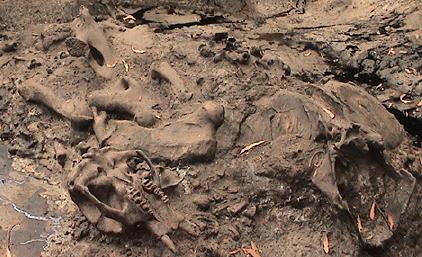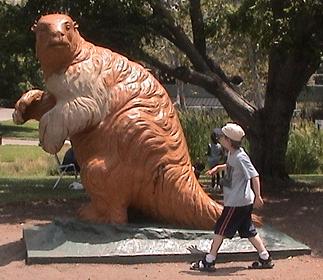
 |
Dinosaur and Paleontology Dictionary |
|||||||
| A | B | C | D | E | F | G | H | I | J | K | L | M | N | O | P | Q | R | S | T | U | V | W | X | Y | Z |
| Fossil Hunters | La Brea Tar Pits | Ice Age Mammals |
The Rancho La Brea Tar Pits are a series of over 100 asphalt pits located in Los Angeles, California, USA ("brea" means "tar" in Spanish). These tar pits contain many animal bones, including Ice Age fossils.
Fossils at La Brea
The Climate in Los Angeles during the Ice Age
For more information on the La Brea Tar Pits, click here.
 Over 650 species of Pleistocene Epoch plants and animals have been found and identified at La Brea (dating from about 10,000 to 40,000 years ago), including many mammoths, mastodons, saber-toothed cats (including Smilodon fatalis), dire wolves (Canis dirus), giant sloths (Glossotherium harlani), ground sloths, bison, a western horse, the short-faced bear (Arctodus simus), rodents, rabbits, birds, turtles, lizards, insects, mollusks, and many other animals and plants. One ancient human skeleton was found in the La Brea pits (about 17 bones from a woman who dates from about 9,000 years ago). The oldest organism found in the La Brea Tar Pits is a wood fragment that dates from 40,000 years ago. The most common large mammals at La Brea are dire wolves (an ancient predator about the size of a modern-day wolf).
Over 650 species of Pleistocene Epoch plants and animals have been found and identified at La Brea (dating from about 10,000 to 40,000 years ago), including many mammoths, mastodons, saber-toothed cats (including Smilodon fatalis), dire wolves (Canis dirus), giant sloths (Glossotherium harlani), ground sloths, bison, a western horse, the short-faced bear (Arctodus simus), rodents, rabbits, birds, turtles, lizards, insects, mollusks, and many other animals and plants. One ancient human skeleton was found in the La Brea pits (about 17 bones from a woman who dates from about 9,000 years ago). The oldest organism found in the La Brea Tar Pits is a wood fragment that dates from 40,000 years ago. The most common large mammals at La Brea are dire wolves (an ancient predator about the size of a modern-day wolf).
During the Ice Ages, the climate in Southern California was wetter and cooler than it is now. The plants that have been found in the tar pits are similar to those that now live about 300 miles to the north of the area (in a cooler, moister coastal region).
What is a Tar Pit?

A life-size model of a giant sloth on the grounds of the La Brea tar pits.
Tar pits are pools of gooey asphalt that are created when crude oil seeps up from deep inside the Earth through a crack (called a fissure). The less dense elements of the crude oil evaporate, leaving a deep, conical deposit of asphalt (a very sticky mess). Water pools atop the tar, attracting thirsty animals. As animals get stuck in the tar, predators are attracted to the trapped animals, and then they get stuck in the asphalt too. (The warmer the weather, the stickier the asphalt - more animals get trapped in the tar in warmer weather.) The animals' bones, teeth, and other hard parts are well-preserved in this environment (but they turn brown as the asphalt seeps into them).
Enchanted Learning®
Over 35,000 Web Pages
Sample Pages for Prospective Subscribers, or click below
|
Overview of Site What's New Enchanted Learning Home Monthly Activity Calendar Books to Print Site Index K-3 Crafts K-3 Themes Little Explorers Picture dictionary PreK/K Activities Rebus Rhymes Stories Writing Cloze Activities Essay Topics Newspaper Writing Activities Parts of Speech Fiction The Test of Time
|
Biology Animal Printouts Biology Label Printouts Biomes Birds Butterflies Dinosaurs Food Chain Human Anatomy Mammals Plants Rainforests Sharks Whales Physical Sciences: K-12 Astronomy The Earth Geology Hurricanes Landforms Oceans Tsunami Volcano |
Languages Dutch French German Italian Japanese (Romaji) Portuguese Spanish Swedish Geography/History Explorers Flags Geography Inventors US History Other Topics Art and Artists Calendars College Finder Crafts Graphic Organizers Label Me! Printouts Math Music Word Wheels |
Click to read our Privacy Policy
| Search the Enchanted Learning website for: |